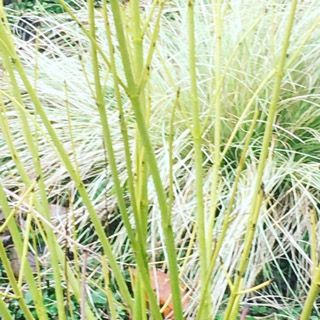
Winter colour, that’s our theme for this month. When we think about colour in the garden, we often think about flowers, but in the winter, these are harder to come by. And much of the winter flower that is available is white, and while that is lovely (albeit not technically a colour), let’s think a little more about stems, leaves, and bark.
Let’s start with stems. There are several shrubs which come into their own once their leaves have dropped and the cooler days are with us.
The first group is the cornus alba, sanguinea and sericea, or flowering dogwood family. Not to be be confused with the cornus florida group which tend to be small to large trees, and hail from North America, the dogwoods come from Siberia and North China principally and come into their own in cold weather. They tend to be shrubs which sprout vigorously from the stool each year if cut back hard, although they can also be developed as small pollarded trees.
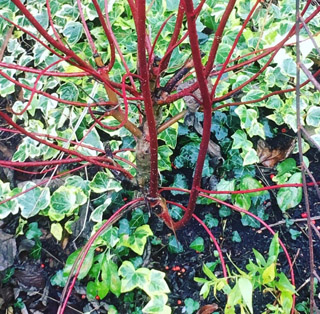
The most remarkable thing about them is their coloured stems which are fundamentally in 2 palettes: the green of the cornus sericea Flaviramera, and the orange to dark red verging on black on the cornus varieties. C. sanguinea Midwinter Fire has stems of vibrant flame colours, C alba sibirica is bright red, and C Kesselringii is the darkest red.
The cornuses look great when mixed with each other or with other plants which contrast (grasses, heathers, evergreen sedges) and show their best colour when cut back hard in spring. Grow in full sun more maximum colour effect, but don’t let theme dry out in the summer. Mostly, they will tolerate quite damp feet.
Another shrub which looks good this time of year is the white-stemmed or ghost bramble, rubus cockburnianus or rubus thibetanus. A relative of our
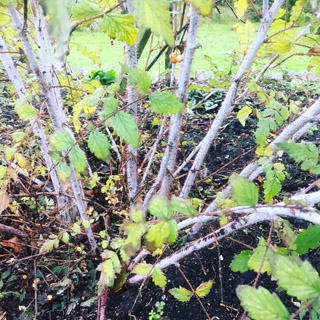
native bramble, this one is more decorative in that its stems are white and ghostly in the winter once all its leaves have dropped, and it does have a charming little pink flower in late spring and summer. Again, it is fresh growth that shows the best colour so cut back hard in the spring for best effect, and put it next to some that will set it off – maybe black grass, or we have seen it to great effect next to dark purple pittosporum Tom Thumb in Pinetum Park’s fabulous winter garden. Take a wander there; it is most striking. Rubus is tolerant of all soil types, including poor stony soil but a word of caution. It is vigorous so give it plenty of room, and be prepared to dig some up now and again as it suckers into a large clump.
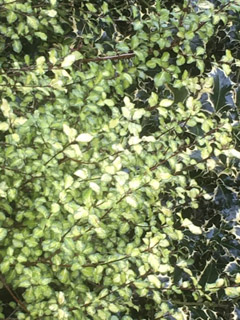
There are 101 (well, maybe that’s an exaggeration) varieties of pittosporum, an evergreen, evening-scented shrub which looks great in the winter. We are lucky here in Cornwall that all types are hardy here, and largely good for coastal settings, (they hail from Australia and other southern hemisphere countries) but beware if you are taking them further north – the paler more variegated varieties don’t cope so well with harsher winters. We have already mentioned P. Tom Thumb, a lovely plummy purple variety, but there are many with a white (P. variegatum or P. Garnettii ) or pinky (P. Elizabeth) variation, yellows and greens, and attractive fine black stems. There is also quite a wide variation in leaf size and shape and habit too, so ask your local friendly garden centre for some advice for your own situation.
Pittosporum like good drainage, and to be out of really cold winds, but give them that, and you can have a very rewarding shrub or small tree in return.
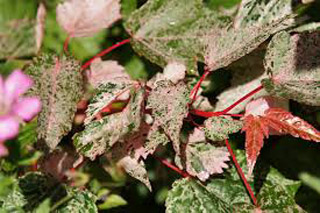 The last group we want to recommend in number are the trees which show off their best bark in winter. We are sure the first one that springs to your mind, as it does ours, is the silver birch or betula jacquemontii group. In small clumps, or in multi-stemmed specimens, the luminescence of their winter bark can be breathtaking – again head to Pinetum Park, or to Stone Lane Gardens up on this edge of Dartmoor which holds the most delightful collection. Worth the hour’s drive.
The last group we want to recommend in number are the trees which show off their best bark in winter. We are sure the first one that springs to your mind, as it does ours, is the silver birch or betula jacquemontii group. In small clumps, or in multi-stemmed specimens, the luminescence of their winter bark can be breathtaking – again head to Pinetum Park, or to Stone Lane Gardens up on this edge of Dartmoor which holds the most delightful collection. Worth the hour’s drive.
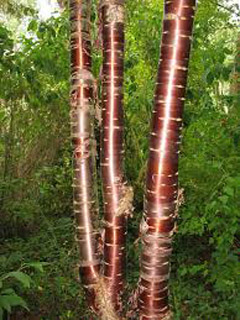
Tall narrow trees, silver birch don’t need to take up too much space, but they won’t like a salty sea wind. Happy with damp feet, they are great for a slightly boggy spot as they soak it up willingly.
Other small trees which have fantastic winter bark effect include Prunus serrula (the Tibetan Cherry), which looks like polished copper with horizontal stripes, Acer davidii (snake bark maple) which is almost green and silver to look at, and the varieties of
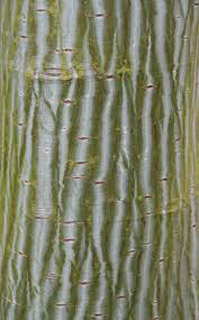
Acer conspicuum, which come in a range of bark colours from yellow through to red, but also have a very attractive variegated leaf in the summer too. All of these are manageably small, and would provided an excellent feature for all but the most coastal gardens.
There, we got through the whole December piece without mentioning Christmas once… curses, it got us at the end! Lots of lovely trees to be had now, along with fun and frolics at various Winter Wonderland events, so have an enjoyable festive season, and see you on the other side
Sarah Daniel (Boss Elf) and Helen Robins (Grumpy Elf), Pengelly Garden Centre
www.pengellygardencentre.co.uk
On Facebook and Instagram
